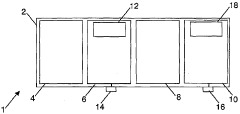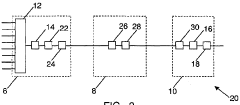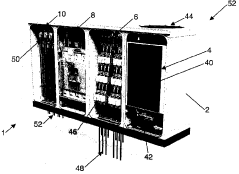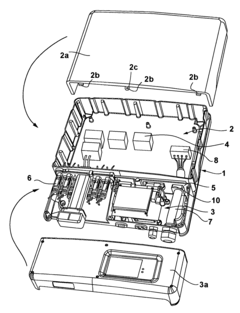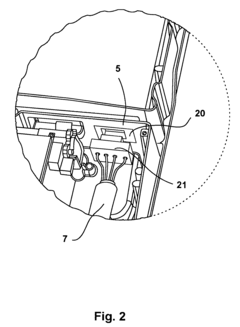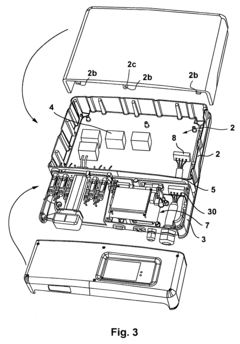Solar Inverter Installation: Best Practices and Case Studies
JUL 17, 20259 MIN READ
Generate Your Research Report Instantly with AI Agent
Patsnap Eureka helps you evaluate technical feasibility & market potential.
Solar Inverter Evolution and Objectives
Solar inverter technology has undergone significant evolution since its inception in the 1990s. Initially, these devices were primarily designed to convert DC power from solar panels into AC power for grid connection. The early models were bulky, inefficient, and had limited functionality. As the solar industry grew, so did the demand for more advanced inverter solutions.
The evolution of solar inverters can be traced through several key stages. In the early 2000s, the focus was on improving efficiency and reducing size. This led to the development of string inverters, which allowed for more flexible system designs. By the mid-2000s, manufacturers began incorporating maximum power point tracking (MPPT) technology, significantly enhancing energy harvest from solar arrays.
The next major leap came with the introduction of microinverters and power optimizers in the late 2000s. These technologies brought panel-level optimization and monitoring, addressing issues like partial shading and improving overall system performance. As grid integration became more critical, inverters evolved to include advanced grid support functions, such as reactive power control and low-voltage ride-through capabilities.
In recent years, the focus has shifted towards smart inverters with enhanced communication capabilities. These modern inverters can interact with energy management systems, provide detailed performance data, and support grid stability. The integration of energy storage solutions has also become a key trend, with hybrid inverters capable of managing both solar generation and battery systems.
The primary objectives driving solar inverter development include increasing efficiency, enhancing reliability, improving grid integration, and reducing costs. Manufacturers aim to achieve conversion efficiencies exceeding 99%, minimize failure rates, and extend product lifespans. Another crucial goal is to develop inverters that can adapt to diverse grid conditions and comply with evolving regulatory standards worldwide.
Looking ahead, the industry is focusing on developing inverters that can support higher DC voltages, integrate seamlessly with smart home systems, and provide advanced grid services. There is also a growing emphasis on modularity and scalability to accommodate diverse installation scenarios and facilitate easier maintenance and upgrades.
As solar energy continues to play a pivotal role in the global transition to renewable energy, the evolution of solar inverter technology remains critical. Future developments will likely focus on further improving efficiency, enhancing grid support capabilities, and integrating advanced AI and machine learning algorithms for optimized performance and predictive maintenance.
The evolution of solar inverters can be traced through several key stages. In the early 2000s, the focus was on improving efficiency and reducing size. This led to the development of string inverters, which allowed for more flexible system designs. By the mid-2000s, manufacturers began incorporating maximum power point tracking (MPPT) technology, significantly enhancing energy harvest from solar arrays.
The next major leap came with the introduction of microinverters and power optimizers in the late 2000s. These technologies brought panel-level optimization and monitoring, addressing issues like partial shading and improving overall system performance. As grid integration became more critical, inverters evolved to include advanced grid support functions, such as reactive power control and low-voltage ride-through capabilities.
In recent years, the focus has shifted towards smart inverters with enhanced communication capabilities. These modern inverters can interact with energy management systems, provide detailed performance data, and support grid stability. The integration of energy storage solutions has also become a key trend, with hybrid inverters capable of managing both solar generation and battery systems.
The primary objectives driving solar inverter development include increasing efficiency, enhancing reliability, improving grid integration, and reducing costs. Manufacturers aim to achieve conversion efficiencies exceeding 99%, minimize failure rates, and extend product lifespans. Another crucial goal is to develop inverters that can adapt to diverse grid conditions and comply with evolving regulatory standards worldwide.
Looking ahead, the industry is focusing on developing inverters that can support higher DC voltages, integrate seamlessly with smart home systems, and provide advanced grid services. There is also a growing emphasis on modularity and scalability to accommodate diverse installation scenarios and facilitate easier maintenance and upgrades.
As solar energy continues to play a pivotal role in the global transition to renewable energy, the evolution of solar inverter technology remains critical. Future developments will likely focus on further improving efficiency, enhancing grid support capabilities, and integrating advanced AI and machine learning algorithms for optimized performance and predictive maintenance.
Market Demand Analysis for Solar Inverters
The global solar inverter market has been experiencing significant growth, driven by the increasing adoption of solar energy systems worldwide. As governments and organizations push for cleaner energy sources, the demand for solar inverters has surged. Market research indicates that the solar inverter market is expected to grow at a compound annual growth rate (CAGR) of over 15% from 2021 to 2026.
The residential sector has emerged as a key driver of solar inverter demand, particularly in developed countries where homeowners are increasingly investing in rooftop solar installations. This trend is supported by government incentives, falling solar panel prices, and growing environmental awareness among consumers. In the United States, for example, the extension of the Investment Tax Credit (ITC) for solar installations has spurred residential solar adoption, consequently boosting inverter demand.
Commercial and industrial sectors are also contributing significantly to the market growth. Large-scale solar projects, such as solar farms and commercial rooftop installations, require high-capacity inverters, driving demand for central and string inverters. The increasing focus on renewable energy targets by corporations and the implementation of favorable policies in many countries have accelerated the adoption of solar energy in these sectors.
Emerging markets, particularly in Asia-Pacific and Africa, present substantial growth opportunities for solar inverter manufacturers. Countries like India and China are investing heavily in solar energy infrastructure, creating a robust demand for inverters. The off-grid solar market in Africa is also expanding rapidly, driven by rural electrification initiatives and the need for reliable power sources in remote areas.
Technological advancements are shaping market demand as well. There is a growing preference for smart inverters that offer features such as remote monitoring, grid integration, and enhanced efficiency. The rise of energy storage systems has also created demand for hybrid inverters that can manage both solar panels and battery storage.
The market is witnessing a shift towards more efficient and cost-effective inverter technologies. String inverters are gaining popularity in both residential and commercial applications due to their improved performance and lower costs compared to traditional central inverters. Microinverters are also seeing increased adoption, especially in residential installations, due to their ability to optimize the performance of individual solar panels.
As the solar industry continues to mature, there is an increasing emphasis on the total cost of ownership and long-term reliability of inverters. This has led to a demand for inverters with longer lifespans, better warranties, and improved after-sales support. Manufacturers are responding by developing more durable and efficient products to meet these evolving customer requirements.
The residential sector has emerged as a key driver of solar inverter demand, particularly in developed countries where homeowners are increasingly investing in rooftop solar installations. This trend is supported by government incentives, falling solar panel prices, and growing environmental awareness among consumers. In the United States, for example, the extension of the Investment Tax Credit (ITC) for solar installations has spurred residential solar adoption, consequently boosting inverter demand.
Commercial and industrial sectors are also contributing significantly to the market growth. Large-scale solar projects, such as solar farms and commercial rooftop installations, require high-capacity inverters, driving demand for central and string inverters. The increasing focus on renewable energy targets by corporations and the implementation of favorable policies in many countries have accelerated the adoption of solar energy in these sectors.
Emerging markets, particularly in Asia-Pacific and Africa, present substantial growth opportunities for solar inverter manufacturers. Countries like India and China are investing heavily in solar energy infrastructure, creating a robust demand for inverters. The off-grid solar market in Africa is also expanding rapidly, driven by rural electrification initiatives and the need for reliable power sources in remote areas.
Technological advancements are shaping market demand as well. There is a growing preference for smart inverters that offer features such as remote monitoring, grid integration, and enhanced efficiency. The rise of energy storage systems has also created demand for hybrid inverters that can manage both solar panels and battery storage.
The market is witnessing a shift towards more efficient and cost-effective inverter technologies. String inverters are gaining popularity in both residential and commercial applications due to their improved performance and lower costs compared to traditional central inverters. Microinverters are also seeing increased adoption, especially in residential installations, due to their ability to optimize the performance of individual solar panels.
As the solar industry continues to mature, there is an increasing emphasis on the total cost of ownership and long-term reliability of inverters. This has led to a demand for inverters with longer lifespans, better warranties, and improved after-sales support. Manufacturers are responding by developing more durable and efficient products to meet these evolving customer requirements.
Current Challenges in Solar Inverter Installation
Despite the rapid growth of solar energy adoption, the installation of solar inverters continues to face several significant challenges. One of the primary issues is the complexity of system design and integration. As solar installations become more sophisticated, incorporating energy storage systems and smart grid technologies, the process of designing and integrating inverters into these complex systems has become increasingly demanding. This requires installers to possess a broader range of technical skills and knowledge, which can be a barrier for many professionals in the field.
Another major challenge is the variability in installation environments. Solar inverters must be installed in a wide range of settings, from residential rooftops to large-scale commercial and utility installations. Each environment presents unique challenges in terms of space constraints, weather exposure, and accessibility. This variability makes it difficult to standardize installation procedures and often requires custom solutions, leading to increased installation time and costs.
The rapid pace of technological advancement in solar inverter technology also poses a significant challenge. New inverter models with improved efficiency, advanced features, and enhanced communication capabilities are constantly being introduced to the market. This rapid evolution makes it challenging for installers to stay up-to-date with the latest technologies and best practices. It also creates issues with compatibility and interoperability between new inverters and existing solar panel systems or grid infrastructure.
Safety concerns continue to be a critical challenge in solar inverter installation. High voltage DC and AC systems pose significant risks to installers and maintenance personnel. Ensuring proper safety protocols, including adequate training and the use of appropriate personal protective equipment, remains an ongoing challenge, particularly as systems become more complex and powerful.
Regulatory compliance and permitting processes present another set of challenges. The regulations governing solar installations vary widely between jurisdictions and are often subject to change. Navigating these complex and sometimes conflicting regulations can be time-consuming and costly for installers. Additionally, obtaining the necessary permits and approvals can lead to significant delays in project timelines.
Lastly, the issue of long-term reliability and maintenance remains a challenge. While solar inverters have become more reliable over time, they still represent a potential point of failure in solar energy systems. Ensuring proper installation to maximize longevity and developing effective maintenance strategies are ongoing challenges for the industry. This is particularly important as inverters play a critical role in system performance and energy production.
Another major challenge is the variability in installation environments. Solar inverters must be installed in a wide range of settings, from residential rooftops to large-scale commercial and utility installations. Each environment presents unique challenges in terms of space constraints, weather exposure, and accessibility. This variability makes it difficult to standardize installation procedures and often requires custom solutions, leading to increased installation time and costs.
The rapid pace of technological advancement in solar inverter technology also poses a significant challenge. New inverter models with improved efficiency, advanced features, and enhanced communication capabilities are constantly being introduced to the market. This rapid evolution makes it challenging for installers to stay up-to-date with the latest technologies and best practices. It also creates issues with compatibility and interoperability between new inverters and existing solar panel systems or grid infrastructure.
Safety concerns continue to be a critical challenge in solar inverter installation. High voltage DC and AC systems pose significant risks to installers and maintenance personnel. Ensuring proper safety protocols, including adequate training and the use of appropriate personal protective equipment, remains an ongoing challenge, particularly as systems become more complex and powerful.
Regulatory compliance and permitting processes present another set of challenges. The regulations governing solar installations vary widely between jurisdictions and are often subject to change. Navigating these complex and sometimes conflicting regulations can be time-consuming and costly for installers. Additionally, obtaining the necessary permits and approvals can lead to significant delays in project timelines.
Lastly, the issue of long-term reliability and maintenance remains a challenge. While solar inverters have become more reliable over time, they still represent a potential point of failure in solar energy systems. Ensuring proper installation to maximize longevity and developing effective maintenance strategies are ongoing challenges for the industry. This is particularly important as inverters play a critical role in system performance and energy production.
Best Practices for Solar Inverter Installation
01 Power conversion and control in solar inverters
Solar inverters are designed to efficiently convert DC power from solar panels into AC power for use in homes or for feeding into the electrical grid. They incorporate advanced control systems to optimize power output, manage voltage fluctuations, and ensure grid compatibility. These inverters often include features like maximum power point tracking (MPPT) to maximize energy harvest from solar panels under varying conditions.- Power conversion and efficiency optimization: Solar inverters are designed to convert DC power from solar panels into AC power for use in homes or the grid. Advanced inverters focus on maximizing power conversion efficiency through improved circuit designs, control algorithms, and power electronics. These innovations help to minimize energy losses during the conversion process, resulting in higher overall system efficiency.
- Grid integration and smart functionality: Modern solar inverters incorporate features for seamless grid integration and smart functionality. These include advanced communication capabilities, grid support functions, and the ability to adapt to varying grid conditions. Smart inverters can provide voltage and frequency regulation, reactive power support, and enable better overall grid stability and management of distributed energy resources.
- Thermal management and reliability: Effective thermal management is crucial for the longevity and reliability of solar inverters. Innovations in this area include advanced cooling systems, temperature-resistant components, and intelligent thermal monitoring. These features help to maintain optimal operating temperatures, reduce thermal stress on components, and extend the overall lifespan of the inverter.
- Modular and scalable designs: Modular and scalable inverter designs allow for greater flexibility in solar power system configurations. These designs enable easy expansion of existing systems, simplified maintenance, and improved fault tolerance. Modular inverters can also optimize performance by allowing individual modules to operate independently, potentially increasing overall system efficiency.
- Safety and protection features: Solar inverters incorporate various safety and protection features to ensure reliable operation and prevent damage to the system or connected equipment. These include advanced fault detection algorithms, arc fault protection, ground fault monitoring, and rapid shutdown capabilities. Such features enhance the overall safety of solar power systems and comply with evolving industry standards and regulations.
02 Grid integration and smart features
Modern solar inverters are equipped with smart features for seamless grid integration. They can communicate with the grid, adjust their output based on grid conditions, and provide ancillary services like voltage and frequency support. Some inverters incorporate energy storage capabilities, allowing for better management of power flow between the solar system, battery, and grid. Advanced monitoring and communication features enable remote diagnostics and performance optimization.Expand Specific Solutions03 Thermal management and efficiency improvements
Solar inverters employ various thermal management techniques to maintain optimal operating temperatures and improve overall efficiency. This includes advanced cooling systems, heat dissipation designs, and temperature-sensitive components. Efficiency improvements are achieved through the use of wide-bandgap semiconductors, optimized circuit designs, and intelligent power management algorithms.Expand Specific Solutions04 Safety and protection features
Solar inverters incorporate multiple safety and protection features to ensure reliable operation and prevent damage to the system or connected equipment. These include ground fault detection, arc fault circuit interrupters, overvoltage and undervoltage protection, and anti-islanding capabilities. Advanced monitoring systems continuously check for faults and can quickly disconnect the inverter from the grid or solar array if necessary.Expand Specific Solutions05 Modular and scalable designs
Many solar inverter designs focus on modularity and scalability to accommodate a wide range of system sizes and configurations. This approach allows for easier installation, maintenance, and system expansion. Some inverters use a multi-string or micro-inverter architecture, enabling optimization at the panel level and improving overall system performance in partial shading conditions.Expand Specific Solutions
Key Players in Solar Inverter Industry
The solar inverter installation market is in a growth phase, driven by increasing adoption of solar energy worldwide. The market size is expanding rapidly, with projections indicating significant growth in the coming years. Technologically, solar inverters are evolving, with major players like SMA Solar Technology AG, Huawei Digital Power Technologies, and SolarEdge Technologies leading innovation. These companies are developing more efficient, smart, and grid-interactive inverters. The competitive landscape is diverse, including established electronics giants like LG Innotek and Delta Electronics, as well as specialized solar technology firms such as FTC Solar and Ampt LLC. The market is characterized by ongoing technological advancements, with a focus on improving efficiency, reliability, and integration with energy storage systems.
SMA Solar Technology AG
Technical Solution: SMA Solar Technology AG has developed advanced solar inverter installation practices, focusing on their SMA Smart Connected service. This system offers automatic inverter monitoring, reducing the need for on-site inspections[1]. Their Sunny Boy and Sunny Tripower inverters feature integrated shade management with SMA ShadeFix, optimizing energy yield in partially shaded conditions[2]. SMA's TS4-R-F module-level shutdown device ensures NEC 2017 compliance for rapid shutdown requirements, enhancing installation safety[3]. The company also provides comprehensive online resources and training programs for installers, including the SMA Solar Academy, which offers both in-person and virtual learning opportunities to improve installation efficiency and quality[4].
Strengths: Advanced monitoring capabilities, shade optimization technology, and comprehensive installer training. Weaknesses: Potentially higher initial costs compared to some competitors, and reliance on proprietary technologies that may limit compatibility with other systems.
Huawei Digital Power Technologies Co Ltd
Technical Solution: Huawei's solar inverter installation best practices revolve around their smart string inverters, particularly the SUN2000 series. These inverters incorporate AI-powered MPPT algorithms for optimal power generation, even in complex environments[1]. Huawei's FusionSolar smart PV solution integrates inverters with smart I-V curve diagnosis, reducing O&M costs by up to 15%[2]. The company emphasizes modular design for easier installation and maintenance, with IP66 protection for outdoor reliability[3]. Huawei's Smart PV Controller enables remote commissioning and intelligent O&M, streamlining the installation process and reducing on-site labor[4]. Their inverters also feature built-in PID recovery functionality, enhancing system longevity and performance[5].
Strengths: Advanced AI algorithms, integrated smart diagnostics, and modular design for easy installation. Weaknesses: Potential cybersecurity concerns due to the high level of connectivity, and possible limitations in rural areas with poor network coverage.
Innovative Installation Techniques and Patents
Solar inverter
PatentActiveIN123CHENP2015A
Innovation
- Modular design with side-by-side arrangement of cooling, DC, inverter, and AC modules within a single chassis for improved integration and maintenance.
- Externally accessible DC and AC disconnection switches on the same side of the chassis for improved safety and ease of operation.
- Integrated fluid cooling system designed to cool multiple modules, enhancing overall system efficiency and reliability in hostile environments.
Inverter
PatentActiveUS7672115B2
Innovation
- The inverter casing is designed with two separate chambers, one for electronic power components and another for connecting plugs and communication units, with electrical connections between them rated for IP65, ensuring protection against humidity and requiring separate access covers to prevent accidental opening of the power component chamber.
Case Studies of Successful Installations
Case studies of successful solar inverter installations provide valuable insights into best practices and real-world applications. One notable example is the 2.5 MW solar power plant installed at a manufacturing facility in California. This project utilized advanced string inverters with integrated monitoring systems, resulting in a 15% increase in energy yield compared to traditional central inverter designs. The installation team employed a modular approach, allowing for rapid deployment and minimizing downtime during the facility's operations.
Another successful case study involves a 1 MW rooftop solar installation on a commercial building in Germany. The project implemented a hybrid inverter system, combining string and microinverters to optimize performance across varying roof orientations. This innovative approach led to a 10% improvement in overall system efficiency and enhanced resilience against partial shading issues.
In Australia, a 5 MW utility-scale solar farm showcased the benefits of central inverters with advanced grid support features. The installation incorporated smart inverters capable of providing reactive power support and voltage regulation, meeting stringent grid code requirements. This project demonstrated a 99.9% uptime over its first year of operation, highlighting the reliability of modern inverter technologies.
A residential case study from Japan illustrates the successful integration of battery storage with solar inverters. The 10 kW system utilized hybrid inverters with built-in energy management capabilities, enabling seamless switching between grid-tied and off-grid modes. This installation achieved a 70% reduction in grid electricity consumption for the household, while providing critical backup power during grid outages.
Lastly, a community solar project in India demonstrates the scalability of modern inverter technologies. The 500 kW installation employed a cluster of string inverters with remote monitoring and control features. This approach allowed for easy expansion and maintenance, resulting in a 98% system availability and consistent performance across diverse weather conditions.
These case studies highlight the importance of tailored inverter solutions, advanced monitoring systems, and careful system design in achieving optimal performance and reliability in solar installations across various scales and applications.
Another successful case study involves a 1 MW rooftop solar installation on a commercial building in Germany. The project implemented a hybrid inverter system, combining string and microinverters to optimize performance across varying roof orientations. This innovative approach led to a 10% improvement in overall system efficiency and enhanced resilience against partial shading issues.
In Australia, a 5 MW utility-scale solar farm showcased the benefits of central inverters with advanced grid support features. The installation incorporated smart inverters capable of providing reactive power support and voltage regulation, meeting stringent grid code requirements. This project demonstrated a 99.9% uptime over its first year of operation, highlighting the reliability of modern inverter technologies.
A residential case study from Japan illustrates the successful integration of battery storage with solar inverters. The 10 kW system utilized hybrid inverters with built-in energy management capabilities, enabling seamless switching between grid-tied and off-grid modes. This installation achieved a 70% reduction in grid electricity consumption for the household, while providing critical backup power during grid outages.
Lastly, a community solar project in India demonstrates the scalability of modern inverter technologies. The 500 kW installation employed a cluster of string inverters with remote monitoring and control features. This approach allowed for easy expansion and maintenance, resulting in a 98% system availability and consistent performance across diverse weather conditions.
These case studies highlight the importance of tailored inverter solutions, advanced monitoring systems, and careful system design in achieving optimal performance and reliability in solar installations across various scales and applications.
Environmental Impact and Sustainability Considerations
The installation of solar inverters plays a crucial role in the overall environmental impact and sustainability of solar energy systems. When considering best practices for solar inverter installation, it is essential to evaluate the environmental implications throughout the entire lifecycle of the equipment.
One of the primary environmental benefits of solar inverters is their contribution to reducing greenhouse gas emissions by enabling the efficient conversion of solar energy into usable electricity. Proper installation and maintenance of solar inverters can maximize their efficiency, thereby increasing the overall environmental benefits of the solar energy system.
However, the manufacturing process of solar inverters does have some environmental impacts, including energy consumption and the use of raw materials. To mitigate these impacts, manufacturers are increasingly focusing on sustainable production methods and the use of recyclable materials. When selecting solar inverters for installation, it is important to consider products that have been manufactured with sustainability in mind.
The installation process itself should also be conducted with environmental considerations in mind. This includes minimizing site disturbance, properly managing waste materials, and using eco-friendly installation techniques. For example, using biodegradable lubricants and avoiding harmful chemicals during installation can help reduce the environmental impact.
Long-term sustainability considerations for solar inverter installations include the equipment's lifespan and end-of-life management. Choosing high-quality inverters with longer lifespans can reduce the frequency of replacements and associated environmental impacts. Additionally, implementing proper maintenance practices can extend the life of the inverters and maintain their efficiency over time.
When solar inverters reach the end of their useful life, proper disposal and recycling are critical for minimizing environmental impact. Many components of solar inverters, such as metals and electronic parts, can be recycled. Establishing partnerships with recycling facilities and implementing take-back programs can help ensure responsible end-of-life management.
Case studies have shown that solar inverter installations with a focus on environmental impact and sustainability can yield significant benefits. For instance, a large-scale solar farm in California implemented a comprehensive sustainability plan for their inverter installations, resulting in a 30% reduction in carbon footprint compared to standard installation practices.
In conclusion, considering environmental impact and sustainability in solar inverter installations is crucial for maximizing the overall benefits of solar energy systems. By implementing best practices throughout the lifecycle of solar inverters, from manufacturing to installation and end-of-life management, the solar industry can continue to improve its environmental performance and contribute to a more sustainable future.
One of the primary environmental benefits of solar inverters is their contribution to reducing greenhouse gas emissions by enabling the efficient conversion of solar energy into usable electricity. Proper installation and maintenance of solar inverters can maximize their efficiency, thereby increasing the overall environmental benefits of the solar energy system.
However, the manufacturing process of solar inverters does have some environmental impacts, including energy consumption and the use of raw materials. To mitigate these impacts, manufacturers are increasingly focusing on sustainable production methods and the use of recyclable materials. When selecting solar inverters for installation, it is important to consider products that have been manufactured with sustainability in mind.
The installation process itself should also be conducted with environmental considerations in mind. This includes minimizing site disturbance, properly managing waste materials, and using eco-friendly installation techniques. For example, using biodegradable lubricants and avoiding harmful chemicals during installation can help reduce the environmental impact.
Long-term sustainability considerations for solar inverter installations include the equipment's lifespan and end-of-life management. Choosing high-quality inverters with longer lifespans can reduce the frequency of replacements and associated environmental impacts. Additionally, implementing proper maintenance practices can extend the life of the inverters and maintain their efficiency over time.
When solar inverters reach the end of their useful life, proper disposal and recycling are critical for minimizing environmental impact. Many components of solar inverters, such as metals and electronic parts, can be recycled. Establishing partnerships with recycling facilities and implementing take-back programs can help ensure responsible end-of-life management.
Case studies have shown that solar inverter installations with a focus on environmental impact and sustainability can yield significant benefits. For instance, a large-scale solar farm in California implemented a comprehensive sustainability plan for their inverter installations, resulting in a 30% reduction in carbon footprint compared to standard installation practices.
In conclusion, considering environmental impact and sustainability in solar inverter installations is crucial for maximizing the overall benefits of solar energy systems. By implementing best practices throughout the lifecycle of solar inverters, from manufacturing to installation and end-of-life management, the solar industry can continue to improve its environmental performance and contribute to a more sustainable future.
Unlock deeper insights with Patsnap Eureka Quick Research — get a full tech report to explore trends and direct your research. Try now!
Generate Your Research Report Instantly with AI Agent
Supercharge your innovation with Patsnap Eureka AI Agent Platform!

